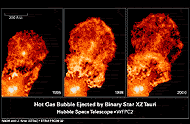|
COMETS EARTH JUPITER KUIPER BELT MARS MERCURY METEORITES NEPTUNE OORT CLOUD PLUTO SATURN SOLAR SYSTEM SPACE SUN URANUS VENUS ORDER PRINTS
PHOTO CATEGORIES SCIENCEVIEWS AMERICAN INDIAN AMPHIBIANS BIRDS BUGS FINE ART FOSSILS THE ISLANDS HISTORICAL PHOTOS MAMMALS OTHER PARKS PLANTS RELIGIOUS REPTILES SCIENCEVIEWS PRINTS
|
Related Documents
Download Options
These images taken with the Hubble Space Telescope's Wide Field and Planetary Camera 2 reveal the evolution of bubbles of glowing gas being blown out from the young binary star system XZ Tauri. Gas from an unseen disk around one or both of the stars is channeled through magnetic fields surrounding the binary system and then is forced out into space at nearly 300,000 miles per hour (540,000 kilometers per hour). This outflow, which is only about 30 years old, extends nearly 60 billion miles (96 billion kilometers). Hubble first discovered this unique bubble in 1995, and additional observations were made between 1998 and 2000. These images show that there was a dramatic change in its appearance between 1995 and 1998. In 1995, the bubble's edge was the same brightness as its interior. However, when Hubble took another look at XZ Tauri in 1998, the edge was suddenly brighter. This brightening is probably caused by the hot gas cooling off, which allows electrons in the gas to recombine with atoms, a process that gives off light. This is the first time that astronomers have seen such a cooling zone "turn on." These images provide an unprecedented opportunity to study the development of a very recent outflow from young (about 1 million years old) stars. Credits: NASA, John Krist (Space Telescope Science Institute), Karl Stapelfeldt (Jet Propulsion Laboratory), Jeff Hester (Arizona State University), Chris Burrows (European Space Agency/Space Telescope Science Institute) |
